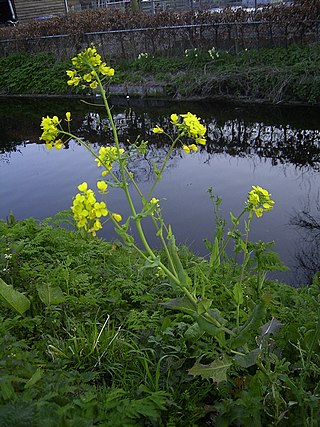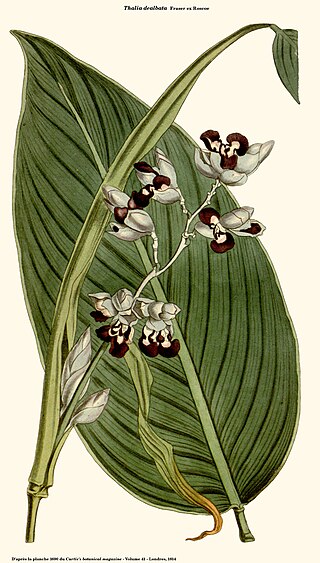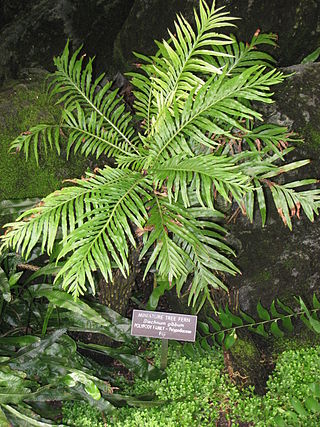
Royal Botanic Gardens, Kew is a non-departmental public body in the United Kingdom sponsored by the Department for Environment, Food and Rural Affairs. An internationally important botanical research and education institution, it employs 1,100 staff. Its board of trustees is chaired by Dame Amelia Fawcett.

Tradescantia is a genus of 85 species of herbaceous perennial wildflowers in the family Commelinaceae, native to the Americas from southern Canada to northern Argentina, including the West Indies. Members of the genus are known by many common names, including inchplant, wandering jew, spiderwort, dayflower and trad.

Brassica is a genus of plants in the cabbage and mustard family (Brassicaceae). The members of the genus are informally known as cruciferous vegetables, cabbages, mustard plants, or simply brassicas. Crops from this genus are sometimes called cole crops—derived from the Latin caulis, denoting the stem or stalk of a plant.

Nathaniel Lord Britton was an American botanist and taxonomist who co-founded the New York Botanical Garden in the Bronx, New York.

Linaceae is a family of flowering plants. The family is cosmopolitan, and includes about 250 species in 14 genera, classified into two subfamilies: the Linoideae and Hugonioideae. Leaves of the Linaceae are always simple; arrangement varies from alternate to opposite or whorled. The hermaphroditic, actinomorphic flowers are pentameric or, very rarely, tetrameric.

Cakile is a genus within the flowering plant family Brassicaceae. Species in this genus are commonly known as searockets, though this name on its own is applied particularly to whatever member of the species is native or most common in the region concerned, the European searocket Cakile maritima in Europe, and the American searocket C. edentula in North America. The genus is native to Europe, Asia and North America, but the European searocket has been introduced into North America and has spread widely on both east and west coasts; in many places it is replacing the native C. edentula, and is regarded as an undesirable invasive species.
Aegilops kotschyi is a member of the grass family, Poaceae, native to the Levant.
Eleocharis geniculata is a species of spikesedge known by several common names, including bent spikerush and Canada spikesedge. This is a widespread plant of wet areas in the Americas, Asia, Africa, Australia, Madagascar, and some Pacific Islands. It is an annual spikesedge growing to a maximum height of about 40 centimeters. It has a few straw-colored leaves and many thin erect stems. The stems hold inflorescences of rounded spikelets each containing at least 10 tiny flowers. The flowers are covered with dark greenish-brown bracts. The fruit is a shiny purple-brown achene not more than a millimeter long.
Alloeochaete is a genus of African plants in the grass family grass family.

Drosera gigantea, the giant sundew, is an erect perennial tuberous species in the carnivorous plant genus Drosera that is endemic to Western Australia. It grows in sandy soils at the margins of swamps and near granite outcrops along the Western Australian coast from Albany north to just south of Geraldton. D. gigantea produces small shield-shaped leaves along many lateral branches that look like a small tree. Individual plants can grow up to 0.2–1 m (0.7–3.3 ft) tall. Because of its tall, tree-like form, it is considered one of the largest Drosera species. It is also easily cultivated and enjoys damp, humid conditions often provided in greenhouses. White flowers emerge from August to November. The red tubers of this species can grow to be 3.8 cm (1.5 in) in diameter and may be a metre below ground.

Alcantarea geniculata is a plant species in the genus Alcantarea. This species is endemic to Brazil.

Thalia is a genus of flowering plants in the Marantaceae family found mainly in aquatic, marshy and riparian zones in Eastern, Central and Western Africa—as far south as Zimbabwe—and the Americas, from Illinois in the north, through northern Argentina in the southern part of its range. These plants can grow with their roots and rhizomes fully submerged and their foliage growing emersed from the water's surface. They thrive in floodplains, vernal pools and other seasonally-inundated areas, as well. Alligator-flag is a common name for plants in this genus. The generic name is in honor of Johannes Thal (1542–1583), a German doctor who wrote A Flora of the Harz Mountains.

Oceaniopteris gibba, the miniature tree fern, is a tropical species of fern in the family Blechnaceae, native to New Caledonia and introduced in Fiji. It has received the Royal Horticultural Society's Award of Garden Merit.

Hermannia is a genus of flowering plants in the mallow family, Malvaceae. It comprises at least 65 species with many more species as yet unresolved.
Plants of the World Online (POWO) is an online database published by the Royal Botanic Gardens, Kew. It was launched in March 2017 with the ultimate aim being "to enable users to access information on all the world's known seed-bearing plants by 2020". This was Kew's answer to the "2020 target 1" of the Convention on Biological Diversity (CBD): "an online flora for all known plants."

World Flora Online is an Internet-based compendium of the world's plant species.

Viscainoa is a genus of flowering plants belonging to the family Zygophyllaceae. It is also in the subfamily of Morkillioideae.

Scandia is a genus of flowering plants belonging to the family Apiaceae. It is also in tribe Aciphylleae, with plants, Gingidia Dawson and Lignocarpa Dawson, with all three genera being native to New Zealand. They are scrambling shrubs with white flowers.

Gibasis geniculata is a trailing plant in the family Commelinaceae, native to Mexico and tropical America.
Rhodalsine geniculata is a species of plants in the family Caryophyllaceae (carpetweeds).















